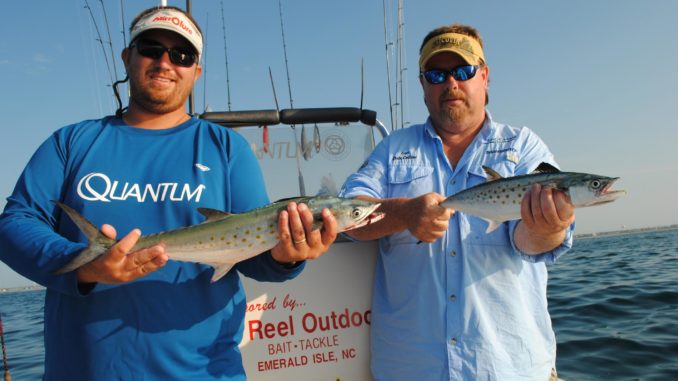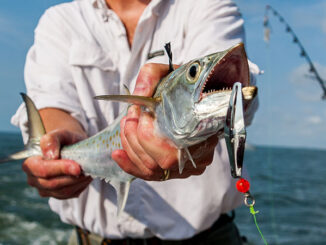
High-speed trolling and free-lining are keys to hooking them, guide says
Spanish mackerel are biting in the Murrells Inlet area, and anglers are catching them using two main tactics. Capt. Justin Witten of Ambush Sport Fishing Charters has been putting his clients on plenty of Spanish in a variety of sizes in the past couple of weeks, and he’s been doing it with a combination of high-speed trolling and free-lining live baits.
Witten (843-685-9910) said the Spanish are thick everywhere from the surf to the jetties, and on out to about 5 miles off the coast, and they are feeding heavily. “I’m catching them around sandbars just beyond the surf, around the jetties, and in open water,” said Witten.
High-speed trolling has been the most consistently productive method of putting Spanish in the boat, and Witten said the key here is to maintain the proper speed. “I like to troll between five and six miles-per-hour. Some days you can be a little high or low, but on other days, you aren’t going to get bit unless you’re in between five and six, so I strive to keep it there all the time,” said Witten.
Wind speed, current, and wind direction can all have an impact on a boat’s speed, so keeping the boat moving at just the right pace can be tricky on some days, so Witten said you really have to be on top of your game.
When trolling this way, Witten likes to have at least two rods out, and he said it’s tough to beat Clark Spoons and Drone Spoons for luring the Spanish in. “Pink, green, and chartreuse are probably the most productive three colors. I’ll troll at least two different colors at a time, and if any one color is really killing the other, I’ll switch to both lures being that color,” he said. But Witten is quick to change back if the bite cools off.
These spoons are two to three inches in length. Witten uses medium to medium-heavy rods, and threads a 3/4-ounce egg sinker on the line, followed by a barrel swivel, a 20-inch leader, then the spoon. This keeps the lures from skipping along the top, but doesn’t allow them to sink more than necessary, and with the speed of the boat, the plugs stay right in the strike zone.
“Sandbars and jetties are always good places to start because fish love to hang out around these spots. In the open water, the best places to troll are easy to find. You just look for the little white birds, which will be diving down to eat the same baitfish that the Spanish are eating,” Witten said.
If Witten has trouble getting bites while trolling, he said free-lining live baits will get the job done. Finger mullet are great choices for live bait this time of year, and Witten said as long as they are swimming freely, he keeps them on the hook. This requires a short, 6 to 12-inch steel leader which Witten attaches to a barrel swivel. Besides the hook, that’s the only terminal tackle used while fishing with this method. Witten either anchors down when free-lining, or trolls at a much slower speed than when using plugs.
“This Spanish we’re catching are ranging anywhere from a pound on up to a little over 6-pounds, and the bigger fish are coming on the plugs while high-speed trolling. These fish are really thick all around Murrells Inlet right now, and I expect them to continue biting for the foreseeable future,” said Witten.





Be the first to comment